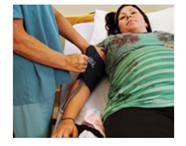
38-Year-Old Female with Preeclampsia
Ms. Johansen, 38, is 26 weeks pregnant with her first child. She was diagnosed with preeclampsia (see p. 1114) three weeks ago. Antihypertensive drugs (p. 724) and daily home care monitoring were initiated. However, her blood pressure is continuing to rise and is now 162/108 mm Hg. She complains of a constant headache, exhibits edema, and her urinalysis is positive for protein.

Her doctor has her admitted and orders further blood tests to assess Ms. Johansen's platelet level and liver function. "We may have to deliver because that’s the only cure for preeclampsia." she says to you during your clinical rotation in obstetrics. “But if we do, then the baby will have problems. It’s a tough decision because we have to balance both the mother's and the baby’s health.”
5. NCLEX-STYLE Cortisol prompts the fetal lungs to begin synthesizing surfactant. Why is this important?
a. Surfactant reduces surface tension in the alveoli, allowing the alveoli to inflate.
b. Surfactant causes vasodilation, allowing blood to flow through the lungs.
c. Surfactant is necessary to protect the cells lining the respiratory tract from drying out.
d. Surfactant attracts white blood cells into the lungs to protect them against pathogens.
Want to see the full answer?
Check out a sample textbook solution
Chapter 28 Solutions
HUMAN A&P E-TEXT ACCESS CODE
- What are intrinsically disordered proteins, and how might they be useful for a living system?arrow_forwardWhat are Amyloid Fibrils? What biological functions are these known to perform?arrow_forwardHow do histamine and prostaglandins help in the mobilization of leukocytes to an injury site? What are chemotactic factors? How do they affect inflammation process?arrow_forward
- Compare and contrast neutrophils and macrophages. Describe two ways they are different and two ways they are similar.arrow_forwardDescribe the effects of three cytokines (not involved in the initial inflammation response). What cells release them?arrow_forwardDescribe activation of helper T cells or cytotoxic T cellsarrow_forward
- Compare and contrast MHC 1 and MHC 2. Describe two way they are different and two ways they similar including how they are used in antigen presentation.arrow_forwardDescribe two antimicrobial properties of the skin.arrow_forwardDescribe how the inflammation response starts including the sentinel cells and the chemicals involved. How do pathogens trigger the response particularly in the skin?arrow_forward
- How does complement promote the immune response? Describe three waysarrow_forwardWhich of the following is not a possible mechanism for autoimmunity? Select one: A. Abnormal expression of MHC II molecules in non-antigen-presenting cells B. Activation of polyclonal B cells C. Polymorphism of HLA alleles D. Molecular mimicry E. Release of sequestered antigensarrow_forwardWRITTEN WORK 3: NON-MENDELIAN GENETICS Part A: Complete the Punnett square and calculate for the probability of genotype and phenotype. i i Genotype: Phenotype: 08:55arrow_forward
- Basic Clinical Lab Competencies for Respiratory C...NursingISBN:9781285244662Author:WhitePublisher:Cengage
- Understanding Health Insurance: A Guide to Billin...Health & NutritionISBN:9781337679480Author:GREENPublisher:Cengage
 Microbiology for Surgical Technologists (MindTap ...BiologyISBN:9781111306663Author:Margaret Rodriguez, Paul PricePublisher:Cengage Learning
Microbiology for Surgical Technologists (MindTap ...BiologyISBN:9781111306663Author:Margaret Rodriguez, Paul PricePublisher:Cengage Learning





